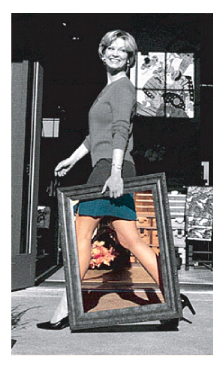Sclerotherapy
Diminishing unsightly 'spider veins'
Millions of women are bothered by spider veins - those small yet unsightly clusters of red, blue or purple veins that most commonly appear on the thighs, calves and ankles. In fact, it's estimated that at least half of the adult female population is plagued with this common cosmetic problem. Today, many Doctors are treating spider veins with sclerotherapy. In this rather simple procedure, veins are injected with a sclerosing solution, which causes them to collapse and fade from view.
The procedure may also remedy the bothersome symptoms associated with spider veins, including aching, burning, swelling and night cramps. If you're considering sclerotherapy to improve the appearance of your legs, this information will give you a basic understanding of the procedure - when it can help, how it's performed and what results you can expect. It won't answer all of your questions, since a lot depends on your individual circumstances. Please ask the consultants, or nurses, if there is anything about the procedure you don't understand.


WHAT ARE SPIDER VEINS?
Spider veins - known in the medical world as telangiectasias or sunburst varicosities - are small, thin veins that lie close to the surface of the skin. Although these super-fine veins are connected with the larger venous system, they are not an essential part of it.
A number of factors contribute to the development of spider veins, including heredity, pregnancy and other events that cause hormonal shifts, weight gain, occupations or activities that require prolonged sitting or standing, and the use of certain medications. Spider veins usually take on one of three basic patterns. They may appear in a true spider shape with a group of veins radiating outward from a dark central point; or they may be simple linear and appear as thin separate lines.
Linear spider veins are commonly seen on the inner knee. Varicose veins differ from spider veins in a number of ways. Varicose veins are larger - usually more than a quarter-inch in diameter, darker in color and tend to bulge. Varicose veins are also more likely to cause pain and be related to more serious vein disorders. For some patients, sclerotherapy can be used to treat varicose veins. However, often surgical treatment is necessary for this condition.
THE BEST CANDIDATES FOR SCLEROTHERAPY
Women of any age may be good candidates for sclerotherapy, but most fall in the 30-to-60 category. In some women, spider veins may become noticeable very early on - in the teen years. For others, the veins may not become obvious until they reach their 40s. If you are pregnant or breastfeeding, you may be advised to postpone sclerotherapy treatment. In most cases, spider veins that surface during pregnancy will disappear on their own within three months after the baby is born. Also, because it's not known how sclerosing solutions may affect breast milk, nursing mothers are usually advised to wait until after they have stopped breastfeeding.
Spider veins in men aren't nearly as common as they are in women. Men who do have spider veins often don't consider them to be a cosmetic problem because the veins are usually concealed by hair growth on the legs. However, sclerotherapy is just as effective for men who seek treatment.

WHAT TO EXPECT FROM SCLEROTHERAPY
Sclerotherapy can enhance your appearance and your self confidence, but it's unrealistic to believe that every affected vein will disappear completely as a result of treatment. After each sclerotherapy session, the veins will appear lighter. Three or more sessions are usually required to achieve optimal results. You should also be aware that the procedure treats only those veins that are currently visible; it does nothing to permanently alter the venous system or prevent new veins from surfacing in the future. Before you decide to have sclerotherapy, think carefully about your expectations and discuss them with our certified consultants.

RISKS RELATED TO TREATMENT
Serious medical complications from sclerotherapy are extremely rare when the procedure is performed by a qualified practitioner. However, they may occur. Risks include the formation of blood clots in the veins, severe inflammation, adverse allergic reactions to the sclerosing solution and skin injury that could leave a small but permanent scar. A common cosmetic complication is pigmentation irregularity - brownish splotches on the affected skin that may take months to fade, sometimes up to a year. Another problem that can occur is "telangiectatic matting," in which fine reddish blood vessels appear around the treated area, requiring further injections.
PLANNING YOUR TREATMENT
During your initial consultation, your legs will be examined. The consultant may draw a simple sketch of your legs, mapping out the areas affected by spider veins or other problems.
During the examination, you will be checked for signs of more serious "deep vein" problems, often indicated by swelling, sores, or skin changes at the ankle. The consultant will ask you about any other problems you may have with your legs, such as pain, aching, itching or tenderness. You will also be asked about your medical history, medications you take, or conditions that would preclude you from having treatment. Individuals with hepatitis, AIDS or other blood-borne diseases may not be candidates for sclerotherapy. Patients with circulatory problems, heart conditions, or diabetes may also be advised against treatment.
It's important to be open in discussing your history and treatment goals with our consultants. Don't hesitate to ask any questions or express any concerns you may have. The consultants should explain the procedure in detail, along with its risks and benefits, the recovery period and the costs. (Medical insurance usually doesn't cover cosmetic procedures.)
PREPARING FOR THE PROCEDURE
You will receive specific instructions from our consultants on how to prepare for your treatment. Carefully following these instructions will help the procedure go more smoothly. You'll be instructed not to apply any type of moisturizer, sunblock or oil to your legs on the day of your procedure. You may want to bring shorts to wear during the injections, as well as your slacks to wear home. When scheduling your procedure, keep in mind that your legs may be bruised or slightly discolored for some weeks afterward. You probably won't be comfortable wearing shorts, a swimsuit or a mini skirt until after your legs have cleared up a bit. Sclerotherapy for the treatment of spider veins is a relatively simple procedure that requires no anesthesia, so it will be performed in an outpatient setting, most likely your doctor's office.
THE PROCEDURE
A typical sclerotherapy session is relatively quick, lasting only about 15 to 45 minutes. After changing into shorts, your legs may be photographed for your medical records. You will be asked to lie down on the examination table and the skin over your spider veins will be cleaned with an antiseptic solution. Using one hand to stretch the skin taut, the nurse will begin injecting the sclerosing agent into the affected veins.
Bright, indirect light and magnification help ensure that the process is completed with maximum precision. Approximately one injection is administered for every inch of spider vein - anywhere from five to 40 injections per treatment session. A cotton ball and compression tape is applied to each area of the leg as it is finished. During the procedure, you may listen to music, read, or just talk to the nurse. You will be asked to shift positions a few times during the process. As the procedure continues, you will feel small needle sticks and possibly a mild burning sensation. However, the needle used is so thin and the sclerosing solution is so mild that pain is usually minimal.
AFTER YOUR TREATMENT
In addition to the compression tape applied during the procedure, tight-fitting support hose may be recommended to guard against blood clots and to promote healing. The tape and cotton balls can be removed after 48 hours. However, you may be instructed to wear the support hose for 72 hours or more. It's not uncommon to experience some cramping in the legs for the first day or two after the injections. This temporary problem usually doesn't require medication.
You should be aware that your treated veins will look worse before they begin to look better. When the compression dressings are removed, you will notice bruising and reddish areas at the injection sites. The bruises will diminish within one month.
In many cases, there may be some residual brownish pigmentation which may take up to a year to completely fade.
GETTING BACK TO NORMAL
Although you probably won't want to wear any leg-baring fashions for about two weeks, your activity will not be significantly limited in any other way from sclerotherapy treatment. You will be encouraged to walk to prevent clots from forming in the deep veins of the legs. However, during the period of time to complete your treatment program, prolonged sitting and standing should be avoided, as should squatting, heavy weight lifting and "pounding" type exercises, including jogging. A one-month healing interval must pass before you may have your second series of injections in the same site. After each treatment, you will notice further improvement of your legs' appearance.
YOUR NEW LOOK
Most patients are pleased with the difference sclerotherapy makes. The skin of your legs will appear younger, clearer and more healthy-looking. If you've been wearing long skirts and slacks to hide your spider veins, you'll now be able to broaden your fashion horizons. Often, patients are surprised at the dramatic difference in appearance between a treated leg and an untreated one. Although sclerotherapy will obliterate the noticeable veins for good, it's important to remember that treatment will not prevent new spider veins from emerging in the future. As time passes, you may find that you need "touch-ups" or full treatments for new veins that surface. But even if you choose not to have further sclerotherapy, your legs will look better than if you never had treatment at all.
California Cosmetic Laser Clinic
1498 S. La Brucherie Rd.
El Centro, CA 92243
Phone (760) 482-5511
Hours of Operation
Tuesday - Friday, 9am to 6pm

No-Interest Patient Financing through CareCredit
Apply Online or in our office.
Instant Response
Quick. Easy. Convenient.

